NVIDIA Launches Shield Tablet
by Joshua Ho on July 22, 2014 9:00 AM EST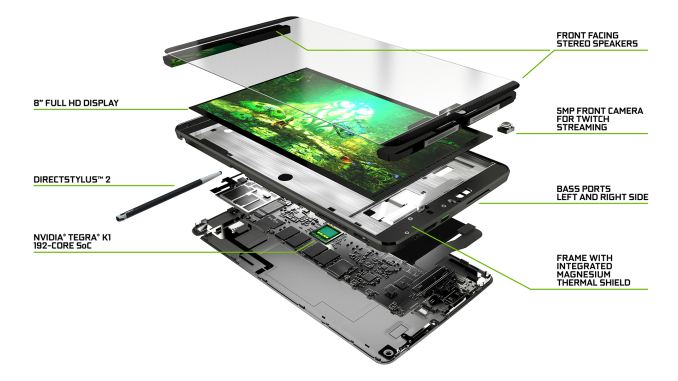
Today, NVIDIA is announcing the Shield tablet. While normally such launch announcements don’t require much in the way of exposition, NVIDIA is in an odd place. Last year, the Shield portable and Tegra Note 7 were the primary mobile devices shipping with Tegra 4. In hindsight, the Shield portable was a bit too niche to ever reach mass adoption. It was first and foremost a gaming device, with a display attached to a controller as opposed to a controller attached to a display. The result was that while it was surprisingly good for gaming, it wasn’t the best tablet. It really only worked in landscape mode, the display size was relatively small (5 inches diagonal), and using the touchscreen was an awkward experience.
The Tegra Note 7 was NVIDIA’s attempt at competing in the mainstream tablet market. While the dual front facing speakers and stylus were good advantages over the Nexus 7, it wasn’t clearly better than the Nexus 7. The display was lower resolution, lower contrast, and not as well calibrated. The WiFi module only supported 2.4 GHz, and there was only a gigabyte of RAM. While it was possible to emulate a Shield-esque experience with the Note 7, there was no game streaming from PC to tablet due to the lack of 5 GHz WiFi, and the controllers on the market simply weren’t as good as the controller in Shield. In addition, because the Tegra Note 7 wasn’t directly controlled by NVIDIA the experience in software update speed could vary.
From the lens of past experience, the Shield tablet makes a lot of sense. The specs are right for a good tablet, but it’s also a proper Shield device. As a tablet, it has all the right pieces. A high resolution display, Tegra K1 (Cortex A15 variant), dual front facing speakers and bass reflex ports, a new stylus, 5 GHz WiFi, and a 5MP front facing camera. I’ve put a table of the specs below for easier reading.
| NVIDIA SHIELD Tablet | |
| SoC | Tegra K1 (2.2 GHz 4x Cortex A15s) |
| RAM/NAND | 2 GB DDR3L-1866, 16/32GB NAND + microSD |
| Display | 8” 1920x1200 IPS LCD |
| Network | 2G / 3G / 4G LTE (NVIDIA Icera i500 UE Category 3/4 LTE) |
| Dimensions | 221 x 126 x 9.2mm, 390 grams |
| Camera | 5MP rear camera, 1.4 µm pixels, 1/4" CMOS size. 5MP FFC |
| Battery | 5197 mAh, 3.8V chemistry (19.75 Whr) |
| OS | Android 4.4.2 |
| Connectivity | 2x2 802.11a/b/g/n + BT 4.0, USB2.0, GPS/GLONASS, mini HDMI 1.4a |
| SIM Size | None or MicroSIM |
In the stylus side, DirectStylus 2 is said to reduce the inking latency to half that of the implementation we saw in Tegra Note 7. In practice it seemed that the stylus latency was low and lines tracked closely to the stylus, but I’ll avoid final judgment until the review. NVIDIA also claims that there are more levels of pressure sensitivity, but it’s not quite clear how many levels there are. NVIDIA has also added handwriting recognition software, which worked relatively well in some casual testing. The Dabbler application also seems to provide a relatively realistic simulation of various physical mediums such as oil painting and watercolor, although it’s mostly targeted towards artists.
In addition to the stylus features, NVIDIA is advertising 1080p Netflix support. Normally, due to the DRM restrictions associated with high bitrate streaming, most Android devices only support low resolution streams. NVIDIA has done all of the necessary work to satisfy these DRM requirements, so it supports the highest bitrate available to mobile devices. Of course, this feature will be disabled with an unlocked bootloader, but it’s a good feature to have for mobile streaming.
Outside of tablet features, the gaming features seem to be quite compelling. The controllers themselves were comfortable, and were very similar to the Shield portable’s ergonomics. NVIDIA is emphasizing that these controllers connect over WiFi direct, and the frequency selected depends upon the network that is used. The result is much lower latency, and NVIDIA is also able to run a headset jack and microphone through the controller due to the higher bandwidth that WiFi provides. Up to four controllers can be paired to the Shield tablet for multiplayer games.
Due to the addition of 5 GHz 2x2 WiFi, NVIDIA’s GameStream and GRID, which means that it’s possible to stream games from a PC within the same LAN to Shield tablet and play games by streaming from NVIDIA servers to the tablet. NVIDIA did note that only 720p is supported through WiFi, and an Ethernet connection is necessary to stream at 1080p due to latency reasons.
While both GameStream and GRID are largely similar in experience compared to the Shield portable, the Kepler GPU in the Tegra K1 enables a great deal of potential for gaming. Trine 2 will ship with the tablet, and is a direct port from the console game. NVIDIA also showed off the improvements in games like Half Life 2 and Portal, which run full OpenGL rather than OpenGL ES as it did on Shield portable. Outside of feature set, NVIDIA is claiming that the K1's GPU is far faster than the GPU in either the Exynos 5420 or Apple's A7 SoC.
In addition, NVIDIA showed off a full version of War Thunder running on Shield tablet, and claimed that it will be able to play on multiplayer with PCs. This included both the tank and aircraft combat aspects of the game. NVIDIA also showed that the Unreal Engine 4 demo from Google IO runs on the Shield tablet.
Finally, the Shield tablet will be the first Android tablet to support streaming to Twitch. By leveraging the built in front facing camera, it’s possible to stream both gameplay and webcam/commentary. In practice, I didn’t see any noticeable issues with this system, and it seemed to work as promised. The 1.4 micron pixel size seemed to make the quality relatively acceptable even indoors.
That was a lot to go over, but I think the key here will be the native gaming experience on Shield tablet. While it’s fully possible for Shield tablet to serve as a dedicated console with GameStream, the real use case will be whether it can provide a solid gaming experience using the SoC for rendering rather than as a video decoder for a PC somewhere else. With games like War Thunder and Trine 2, it seems that there is immense potential for a very compelling product. While NVIDIA isn’t starting from nothing this time around, this ecosystem aspect is still a bit risky.
The Shield tablet will go on sale July 29th for the US, August 14th for Europe. The 16GB/WiFi variant will cost 299 USD, the 32GB/LTE variant will be 399 USD. The controller is priced at 59 USD, and the flip cover at 39 USD.


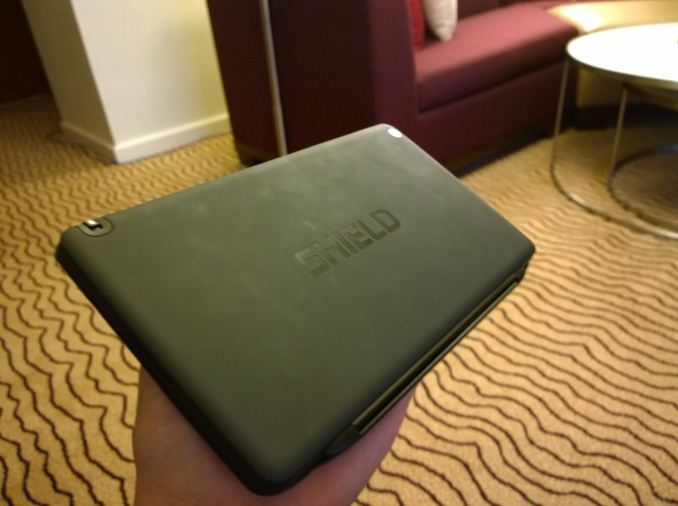
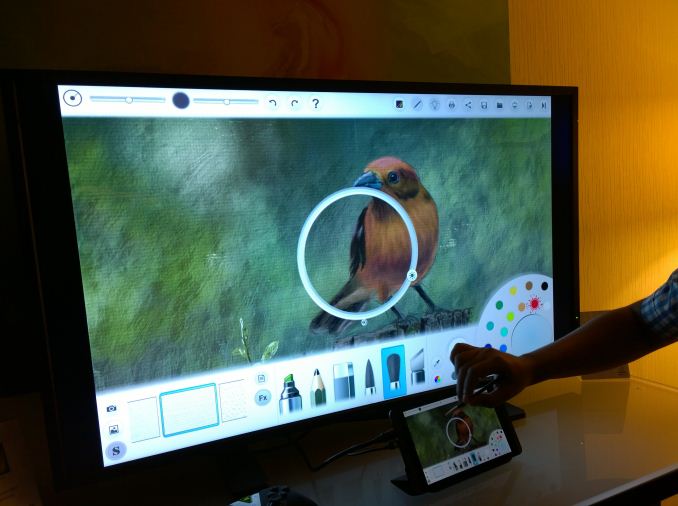
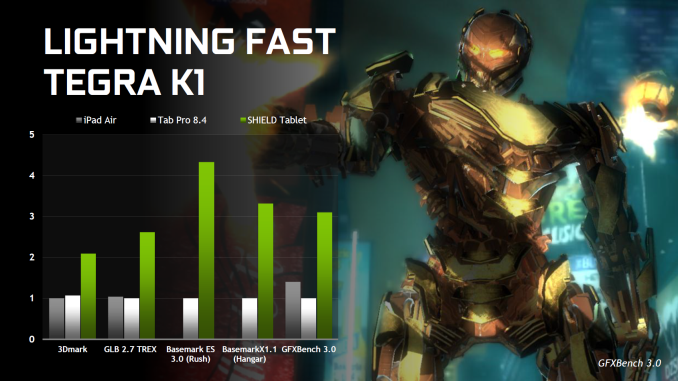

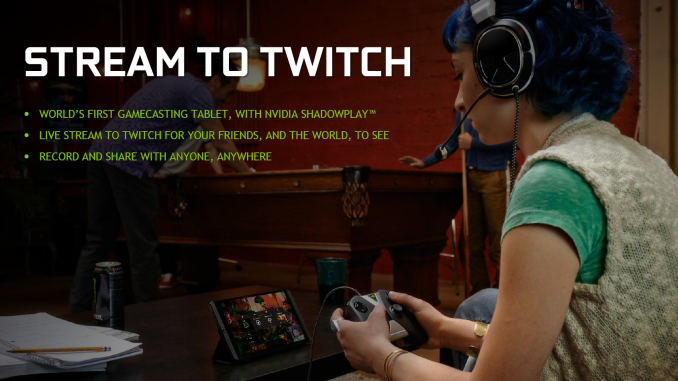








107 Comments
View All Comments
Johnny_k - Wednesday, July 23, 2014 - link
1) They have started with half life 2, portal, trine 2, warthunder2) you can already do this. See: http://shield.nvidia.com/gaming-tablet/
>GameStream gaming outside of your home Wi-Fi network is a BETA feature and requires minimum upload and download bandwidth speeds of 5Mbps. Streaming experience may vary depending on the quality of your Internet.
chizow - Wednesday, July 23, 2014 - link
Wow, that's awesome!!! It is a very obscure footnote so hopefully more attention/testing is made of this when the reviews go live, presumably next week. *IF* this support spreads to more games and handles the latency decently well, I will definitely be picking one of these up. Probably not at release, but I will probably wait until the new Maxwell GPUs are released and see if they do a Shield bundle like they did last Holiday season.This really has some endless possibilities, maybe one day you could use your Shield tablet/portable as a thin client you could bring to LAN parties, gaming events, meet-ups, trade-shows and leave your PC as a server at home. Throw an ethernet to USB dongle on there for even more reliable internet. Obviously not something for pro/competitive gamers, but this would certainly be appealing to more casual/social gamers.
Drumsticks - Tuesday, July 22, 2014 - link
I like it. I don't think it's enough to replace my Nexus 7, but I'll wait for the full review. I'll need to pick up an Nvidia GPU again, but I was planning on doing that soonish anyways.smorebuds - Tuesday, July 22, 2014 - link
If going from Adreno 320 to K1, and having Nvidia streaming features, isn't enough for you, then I guess go ahead and stick with your Nexus 7.dabotsonline - Tuesday, July 22, 2014 - link
"In addition to the stylus features, Nvidia is advertising 1080p Netflix support. Normally, due to the DRM restrictions associated with high bitrate streaming, most Android devices only support low resolution streams. Nvidia has done all of the necessary work to satisfy these DRM requirements, so it supports the highest bitrate available to mobile devices. Of course, this feature will be disabled with an unlocked bootloader, but it’s a good feature to have for mobile streaming."Josh, do you have a link to the Netflix support pages that confirm all of this? All I can find is:
"Netflix HD playback is only available on the new Nexus 7 tablet."
https://help.netflix.com/en/node/237
JoshHo - Tuesday, July 22, 2014 - link
It's likely that the Netflix support pages are out of date. Nvidia stated that they satisfy the DRM requirements multiple times during the briefing.dabotsonline - Wednesday, July 23, 2014 - link
Thanks, JoshHo. The Greenbot review said something similar:"There aren't a lot of Android devices that will stream Netflix in 1080p. Google's Nexus 7 (2013 model) and the new Samsung Galaxy Tab S are notable exceptions. Nvidia now joins that elite club with the Shield Tablet, though I suspect 1080p Netflix streaming will be pretty common in the coming year."
http://www.greenbot.com/article/2455096/no-longer-...
It is true that there are no phones that support 1080p Netflix? Last October, with the release of Netflix 5.0, the iPhone only supported 720p Netflix:
"Also, for those fixated on resolution, we checked with the company and confirmed the streams max out at 720p on the iPhone / iPod touch and 1080p on the iPad."
http://www.engadget.com/2013/10/03/netflix-5-ios-h...
Netflix 6.0 was launched on iOS last month. What I think will be interesting is if the iPhone 6 does indeed come in a 5.5" variant with a 1080p+ screen then, unless Netflix change, a 720p stream will be visibly inferior to a 1080p stream on even a 7" tablet.
Josh, you also said, "Of course, this feature will be disabled with an unlocked bootloader... " Does you have a reference for this specifically?
When you write your review of the SHIELD Tablet, can you please try to unlock the bootlader, install Hangouts and Google Dialer (the 4.4.2 version by TKRuzze, not the newer 4.4.3 version), relock the bootloader and see if it functions as a massive phone? In the full specs for the SHIELD Tablet, it says that a few country models of the EU variant will support voice calling by default, but this could be a hacky approach for those who don't have those models if they wish to have a giant, all-in-one media streaming and communication device. Thanks.
TerdFerguson - Tuesday, July 22, 2014 - link
Until Android security gets beefed up, I'm absolutely uninterested in an Android gaming tablet - especially one featuring a couple of cameras, networking, and cellular connectivity. I certainly wouldn't be interested in spending $500, including accessories, for a gaming device that is clearly much worse in every significant regard than competing consoles.ams23 - Tuesday, July 22, 2014 - link
Shield tablet is simply a really fast pure Android tablet (with stylus) that has an optional accessory for gaming (wireless controller). This is not something that should be used exclusively for gaming! Think of this as a very improved version of the Tegra Note 7 (with larger and higher res screen, much faster and more modern GPU, improved second gen stylus, improved Wifi + connectivity, improved build quality, improved heat dissipation capability).chizow - Tuesday, July 22, 2014 - link
As a standalone gaming machine, I would agree, it is still far behind the similarly priced "next-gen" consoles, but it does offer extra value for some as a "PC extender" console with its GameStream functionality. If you look at it that way, you would get a console experience that is better than competing consoles in most regards since you would be leveraging the power and library of your PC.While the GameStream technology is somewhat interesting to me, I would not pay $300 for a PC-extender, the gaming aspect needs to stand on its own to make this purchase worthwhile, and currently, the Android market isn't interesting enough to me until they start getting more console/PC franchise games. There is also another usage group that this device satisfies as an emulator, but that doesn't really interest me either.